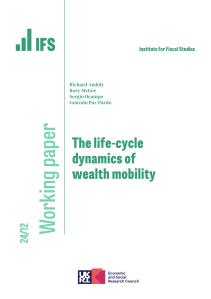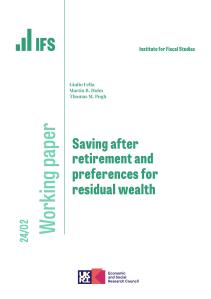Older people in England, on average, hold a lot of wealth. For example, among those aged 55-64 (i.e. on the eve of retirement) median housing wealth is £185,000 and median other wealth (excluding pensions) is around £33,000. A set of new reports – funded by the IFS Retirement Savings Consortium and the Economic and Social Research Council and published today – shows that this wealth, whether held in housing or in financial assets, is not in general drawn down in retirement. This implies that most will be bequeathed to later generations.
Key findings on the use of wealth by current retirees in England include:
• Primary housing is the largest component of (non-pension) wealth held. 80% of the over 50s are home owners. On current trends, the majority home owners at age 50 would not be expected to move before of they die. Of the slightly over two-fifths who would be expected to move, few move for financial reasons, though something like two-thirds of moves do release some housing wealth.
• Financial wealth is on average drawn down, but only slowly. Observed behaviour suggests that on average individuals will draw down just 31% of net financial wealth between ages 70 and 90. Even among individuals in the top half of the financial wealth distribution, net financial wealth looks to be drawn down by just 39%, on average.
• Around one-in-six of those aged 55-64 own a second home. The prevalence of ownership of second homes changes very little at ages 70 and over, and actually increases slightly among those in their late 50s and 60s. Among those in their late 50s and 60s there is a shift away from second homes that do not yield an income towards those that do.
• Most people do not appear to experience large end-of-life expenses that would use up remaining wealth holdings. Among a sample who died between 2002/3 and 2012 only 7% received help with daily activities from a privately paid employee in the two years prior to death. A fifth did stay in a nursing or residential home for some period before death but in total only 7% stayed for six months or more – and not all of these would have paid for this care privately.
This suggests that most wealth held by current retirees will be bequeathed on their death, rather than being spent during their retirement.
The research also examines patterns of bequest giving and finds that:
• Married people nearly always bequeath only to their spouse. The surviving spouse most often bequeaths all of their assets to their children (in 60% of cases for those with financial assets) rather than sharing directly across multiple generations. For example, only 16% of those with financial assets and no surviving spouse directly left any assets to grandchildren (74% had grandchildren).
• Together these findings imply that inheritances will typically only be received at relatively older ages. For example, someone currently aged 40 who was born to a 27 year old mother and an older father might, on average, expect to receive a bequest from their parents at age 63.
• Bequests tend to be made to multiple individuals – for example to several children –, and so inheritances received are generally considerably smaller than the size of individuals’ estates on death. Among those with financial assets who were not survived by a partner, 24% left their assets to two individuals, 16% to three, and 26% to four or more individuals.
There are some reasons to think these patterns of wealth use in retirement might change in future. In particular:
• Many working age people report expecting to draw on non-pension wealth to provide money for their retirement. Of those in their 50s: 40% expect to use savings, 30% expect to use their primary housing, and 10% expect to use other property to finance their retirement.
• If future retirees have lower pensions than current retirees, drawing larger sums from housing wealth may become more prevalent. It is currently those with high housing wealth, and those with the greatest housing wealth relative to their incomes, who draw most on their housing wealth when they move.
• Second home ownership at older ages is increasingly common among generations born more recently: one-in-seven of those born 1950-54 own second homes, compared to one-in-ten of those born 1940-44 and around one-in-twenty of those born 1930-34. Given this higher baseline level of ownership, selling to fund retirement expenditures could be more common in future.
Rowena Crawford, an Associate Director at IFS and author of the set of reports, said:
“Older people do not draw on their wealth much during retirement. The majority of homeowners do not move or access their housing wealth, and even financial wealth is drawn down only slowly. This means that most wealth held by retired people is likely to be bequeathed to future generations, rather than spent. This will have implications for the level and distribution of resources among current working age individuals, particularly those with wealthy parents and few siblings. Given the increased freedom people now have over how they spend their pension wealth in retirement, carefully monitoring how the use of wealth evolves in future will be important, both for the living standards of the retirees themselves, and also for younger generations.”
ENDS
Notes to editors
1. ‘The use of wealth in retirement’ by Rowena Crawford will be available on the IFS website at 00:01 on Monday 11 June 2018 www.ifs.org.uk.
This summarises the findings of three other publications (‘The use of housing wealth at older ages’, ‘The use of financial wealth in retirement’ and ‘An overview of the ELSA ‘End of Life’ data’) that will be published at the same time.
Embargoed copies are available for the press prior to that. Please contact Bonnie Brimstone – @email / 0207 291 4818 / 07730 667013 – if you want a copy or have any queries.
You are also welcome to attend an event on Monday, where these findings will be presented (though the embargo will have passed): https://www.ifs.org.uk/events/1601
2. The authors gratefully acknowledge financial support from the IFS Retirement Savings Consortium and the Economic and Social Research Council (ESRC) which is now part of UK Research and Innovation. The IFS Retirement Savings Consortium comprises Age UK, Association of British Insurers, Chartered Insurance Institute, Department for Work and Pensions, HM Revenue and Customs, HM Treasury, Investment Association, Legal and General Investment Management, Money Advice Service, and Tax Incentivised Savings Association. All errors and omissions remain the responsibility of the authors.
3. This analysis draws on data from the English Longitudinal Study of Ageing (ELSA). Data from ELSA were made available through the UK Data Archive (UKDA). ELSA was developed by a team of researchers based at the National Centre for Social Research, University College London and the Institute for Fiscal Studies. The data were collected by the National Centre for Social Research. The data creators, depositors, copyright holders and funders bear no responsibility for the analysis or interpretation of the data presented here.
4. The figures in the first paragraph are medians, calculated from the English Longitudinal Study of Ageing. The mean equivalents are £230,000 (housing wealth) and £160,000 (non-housing, non-pension wealth), as described in Figure 1 of ‘The use of wealth in retirement’.









